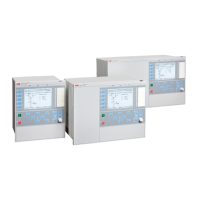3.7.10 Directional underpower protection GUPPDUP (37)
Function description IEC 61850
identification
IEC 60617
identification
ANSI/IEEE C37.2
device number
Directional underpower protection GUPPDUP
SYMBOL-LL V1 EN
37
3.7.10.1 Application
The task of a generator in a power plant is to convert mechanical energy available as a
torque on a rotating shaft to electric energy.
Sometimes, the mechanical power from a prime mover may decrease so much that it
does not cover bearing losses and ventilation losses. Then, the synchronous generator
becomes a synchronous motor and starts to take electric power from the rest of the
power system. This operating state, where individual synchronous machines operate as
motors, implies no risk for the machine itself. If the generator under consideration is
very large and if it consumes lots of electric power, it may be desirable to disconnect it
to ease the task for the rest of the power system.
Often, the motoring condition may imply that the turbine is in a very dangerous state.
The task of the reverse power protection is to protect the turbine and not to protect the
generator itself.
Steam turbines easily become overheated if the steam flow becomes too low or if the
steam ceases to flow through the turbine. Therefore, turbo-generators should have
reverse power protection. There are several contingencies that may cause reverse
power: break of a main steam pipe, damage to one or more blades in the steam turbine
or inadvertent closing of the main stop valves. In the last case, it is highly desirable to
have a reliable reverse power protection. It may prevent damage to an otherwise
undamaged plant.
During the routine shutdown of many thermal power units, the reverse power
protection gives the tripping impulse to the generator breaker (the unit breaker). By
doing so, one prevents the disconnection of the unit before the mechanical power has
become zero. Earlier disconnection would cause an acceleration of the turbine
generator at all routine shutdowns. This should have caused overspeed and high
centrifugal stresses.
When the steam ceases to flow through a turbine, the cooling of the turbine blades will
disappear. Now, it is not possible to remove all heat generated by the windage losses.
Instead, the heat will increase the temperature in the steam turbine and especially of the
1MRK504116-UUS C Section 3
IED application
477
Application manual

